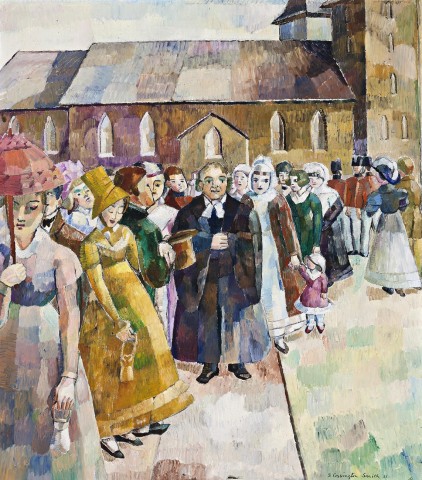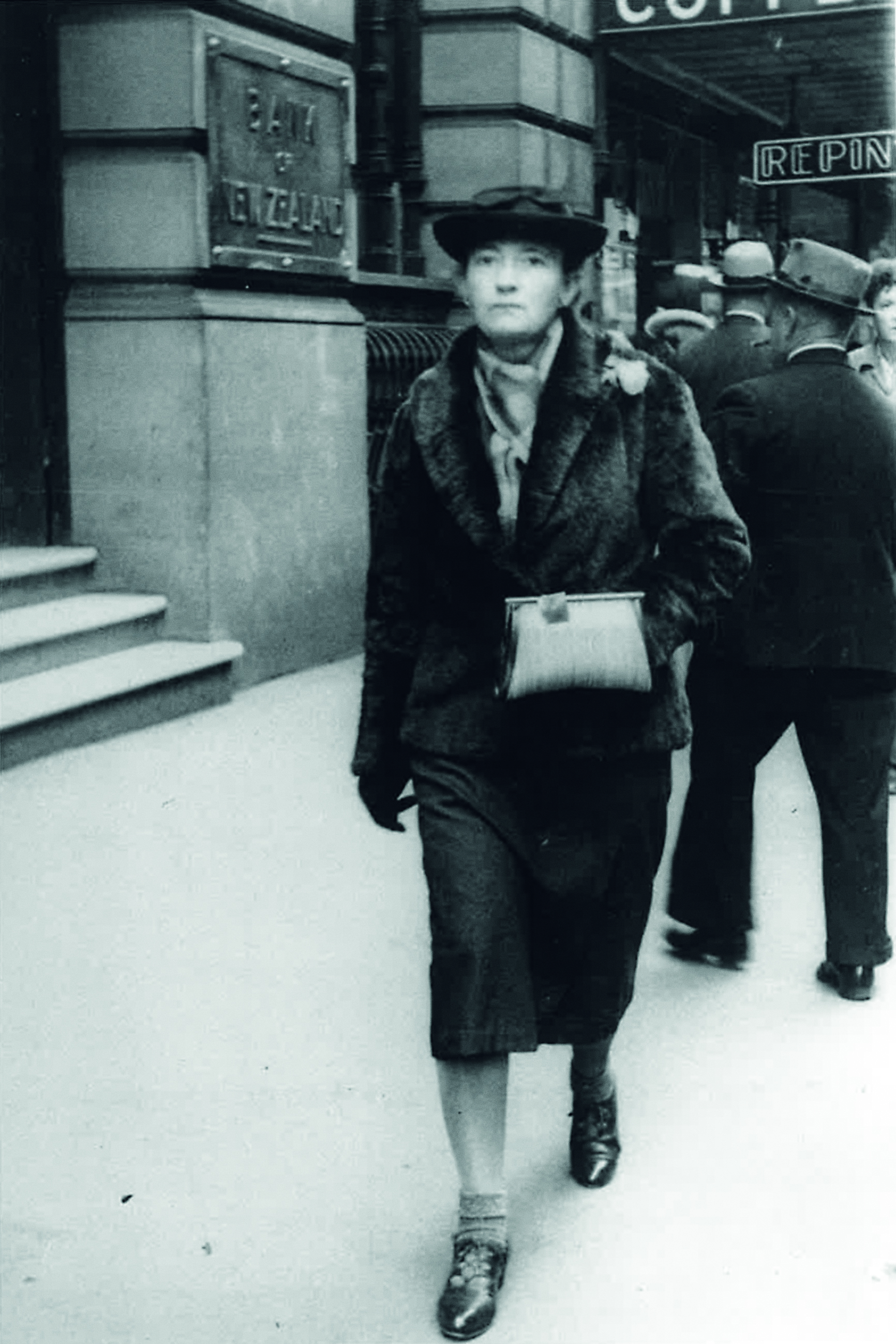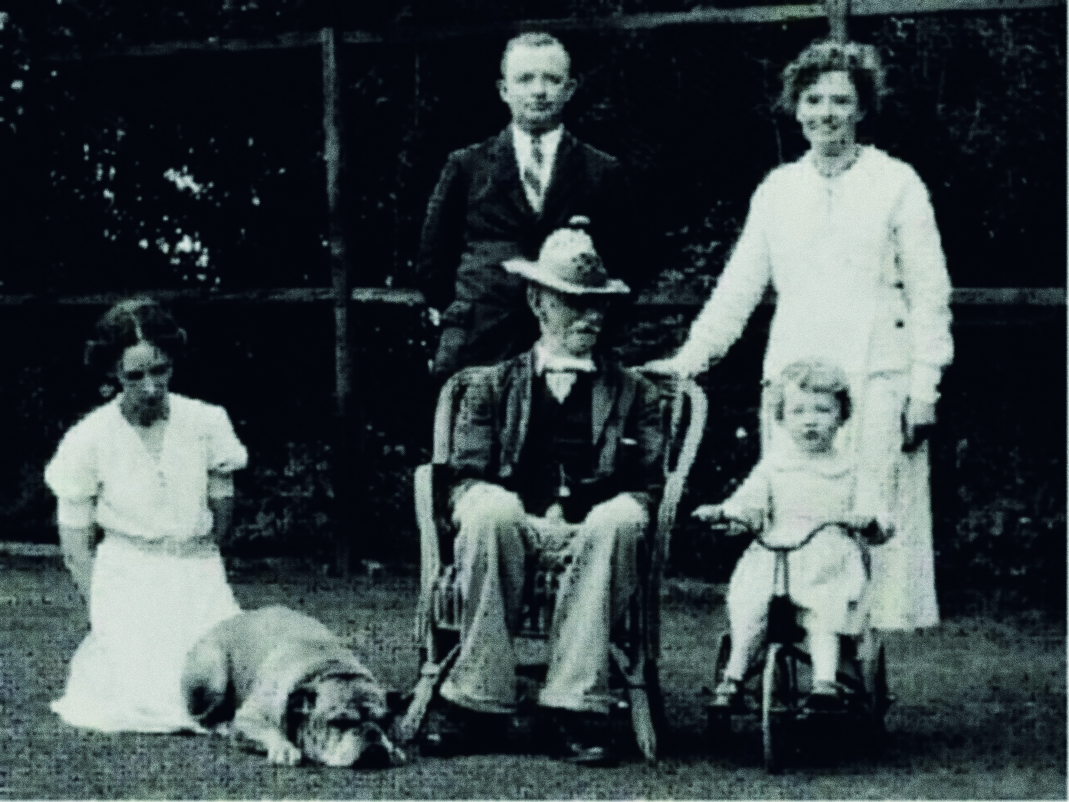SAMUEL MARSDEN AFTER SERVICE AT ST. JOHN’S PARRAMATTA, 1937 – 38
GRACE COSSINGTON SMITH
oil on pulpboard
66.0 x 58.5 cm
signed and dated lower right:
G. Cossington Smith 35
bears inscription on old label verso: “Samuel Marsden after / service at St. Johns / Parramatta” / Grace Cossington Smith / McCAUGHEY PRIZE COMPETITION
Macquarie Galleries, Sydney
Private collection, Melbourne
Art Competitions Exhibition: Australia’s 150th Anniversary Celebrations, 1788 – 1938, Education Department’s Art Gallery, Sydney, 2 – 28 February 1938, cat. 24
Grace Cossington Smith, Macquarie Galleries, Sydney, 21 June – 10 July 1972, cat. 13 (dated as 1935)
Grace Cossington Smith: Survey Exhibition 1919 – 1971, Painters Gallery, Sydney, 8 – 26 September 1986; Niagara Galleries, Melbourne, 7 – 24 October 1987, cat. 19 (illus. in exhibition catalogue, dated as 1935)
Grace Cossington Smith: Loan Exhibition, S. H. Ervin Gallery, Sydney, 18 October – 18 November 1990, cat. 49
James, B., Grace Cossington Smith, Craftsman House, Sydney, 1990, pl. 69, p. 109 (illus.)
By the end of the 1930s, Grace Cossington Smith had hit her creative stride, producing paintings which would confirm her place among the ranks of Australia’s foremost modern artists. ‘The years from 1926 until the late 1930s’, as Deborah Hart has written, ‘were among the most important in (her) artistic life, when her potential as a painter of colour and light, structure and rhythmic pattern, was realised in work after work. It was as though the previous years of concentrated effort and inventiveness in drawing and painting blossomed into her mature vision’.1 1938 was a significant year in Cossington Smith’s life for several reasons: the death of her father propelled her to the head of the family; fellow modernist Thea Proctor highlighted her work in Art in Australia, noting her ‘personal technique, and … lovely and individual colour sense’,2 and for the first time, she was included in a museum exhibition. Shown at the National Art Gallery of New South Wales, Sydney, 150 Years of Australian Art, was organised by the then Director, Will Ashton, and according to the editors of Art in Australia, ‘The hanging of the pictures (was) exceptionally well carried out – a difficult task with eight hundred works so diverse in character and appearance’.3 The motivation for such a massive undertaking was the sesquicentenary of European settlement of Australia, an event which witnessed a flurry of special activities and celebrations to mark the significant historical milestone.
Another such activity which piqued the interest of contemporary visual artists was an art prize administered by the 150th Anniversary Celebration’s Council. In addition to an award of 250 Guineas funded by the Commonwealth Government for a large oil painting depicting an aspect of Australia’s history, smaller prizes were offered for works of various subjects and in various media.4 Beginning work in December 1937 and completing her painting in January of the following year,5 Cossington Smith entered Samuel Marsden After Service at St John’s Church, Parramatta, 1937 – 38 into the category of ‘historical subject in oils’.
While far from a household name, Marsden holds a significant place in Australian colonial history, arriving in 1794 to take up the role of assistant to the chaplain of New South Wales and later, for some years, being the only Anglican clergyman on the mainland.6 Stationed at Parramatta he was the driving force behind the construction of St John’s Church (now Cathedral) on a site which lays claim to being the oldest continuous place of Christian worship in Australia.7 In a letter home to England in late April 1803, Marsden wrote, ‘last Easter Sunday I consecrated my church at Parramatta. This building proves a great comfort to my mind as I can now perform a divine service in a manner becoming the worship of Almighty God. At Sydney there is no place for public worship and I fear will be none for a long time to come … It has been with many years labor and patience I have got a temple erected’.8
Cossington Smith’s highly personal choice of subject reflected her own life as a devout Anglican Christian. Marsden stands firmly at the centre of the image, the strong geometry of the composition leading the eye towards him and beyond, to the church which he was so instrumental in founding. Uniformed figures in the distance and the small child to the right of Marsden, symbolise the development of the settlement from a penal colony to a place where the growing and increasingly free population gathered together for regular worship. Typical of the artist, this work was signed and dated some years after execution, most likely prior to its first commercial exhibition at Macquarie Galleries in 1972 when she was 80 years old. In the catalogue accompanying the major Cossington Smith survey exhibition at the Art Gallery of New South Wales, Sydney in 1973, there are numerous examples of erroneous dating by the artist and Daniel Thomas notes that she ‘never inscribed dates on early paintings’ and those ‘included in the one-man shows of 1968, 1970 and 1972 … were given dates by the artist before being , and these dates ... are sometimes as much as ten years astray’.9 A celebratory picture infused with a deeply personal meaning, this is a fascinating work which perfectly encapsulates Cossington Smith’s belief that ‘painting … (expresses) form in colour – colour vibrant with light’10 and her ability to achieve this in an image redolent with both creative and spiritual joy.
Grace Cossington Smith (right) with her sister Diddy, dog Rex (Krinkley Konks), brother Gordon, father Ernest and young niece Ann (Mills) at Cossington, in Turramurra, in 1937. courtesy of the artist’s estate.
1. Hart, D., Grace Cossington Smith, exhibition catalogue, National Gallery of Australia, Canberra, 2005, p. 27
2. Proctor, T., ’Modern Art in Sydney’, Art in Australia, Sydney, 3rd series, no. 73, November 1938, p. 28
3. Ure Smith, S. & Gellert, L., ‘Editorial’, Art in Australia, Sydney, 3rd series, no. 70, March 1938, p. 13
4. Art Competitions Exhibition: Australia’s 150th Anniversary Celebrations 1788 – 1938, exhibition catalogue, Education Department Gallery, 1938. The major prize was awarded to Ivor Hele for his dramatic depiction of Sturt’s reluctant decision to return 1937 (Art Gallery of South Australia, Adelaide) and B.E. Minns won the historical subject in oils for The Landing at Botany Bay, 1788. Thanks to Jin Whittington, Art Gallery of South Australia Research Library, for her research assistance.
5. James, B., Grace Cossington Smith, Craftsman House, Sydney, 1990, p. 109
6. See: Yarwood, ‘A. T., Marsden, Samuel (1765-1838)’, Australian Dictionary of Biography, National Centre of Biography, Australian National University, http://adb.anu.edu.au/biography/marsden-samuel-2433/text3237, published first in hardcopy 1967, accessed online 22 February 2018
7. http://www.discoverparramatta.com/places/heritage_and_historic_sites/st_..., accessed online 22 February 2018. Towers were added to the 1803 church in 1818 and in 1855, having fallen into disrepair, it was demolished and replaced.
8. Marsden, S., letter to Mrs John Stokes, 27 April 1803, quoted in Mackaness, G., Some Private Correspondence of the Rev. Samuel Marsden and Family 1794-1824, Review Publications, New South Wales, 1976, pp. 30 – 31
9. Thomas, D., Grace Cossington Smith, exhibition catalogue, Art Gallery of New South Wales, Sydney, 1973, p. 9
10. Smith, G.C, quoted in Modjeska, D., Stravinsky’s Lunch, Pan Macmillan, Sydney, 1999, reprinted 2000, flyleaf
KIRSTY GRANT


